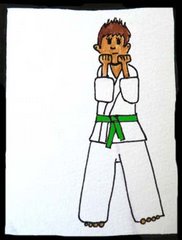It was an icy cold morning. As we drove out to the stadium there was a thick layer of frost on the fallow fields, waiting for the soba sowing. It was much too cold to be running. Manabe Sensei picked me up at 8:30 in the morning; we had to register an hour before the race began at 10:30, and the roads were packed.
The occupants of the cars all around us were fitted out in designer running gear. Manabe San was wearing a brand new pair of runners, bought especially for the occasion. They were crisp and white like the harsh light attacking me through the windows. I wanted to drop them in a muddy puddle for him, but remembered we were in Japan and crisp white sneakers were cool here. My own, though in perfectly good repair, looked somewhat shabby. I’d spent a fair bit of money on them a year ago in lieu of paying fees for a gym I didn’t like. Since then they had been running on beaches, roads, next to the lake at Mum’s place and through the dusty Australian bush. They weren’t a fashion statement despite the expensive logo that could get me into trouble with many of my peers. I didn’t even own a pair of trackpants. A decision I was regretting as I looked out at the frosty soil. I’d looked in the sports stores, but reused to outlay upwards of $60 on clothing I would probably only wear around my house.
At the end of last year Manabe Sensei had come into school proudly bearing an English copy of an application form for the Marugame Half Marathon, and invited me to run with him. It would be the 60th Anniversary and therefore somewhat of an event. The organisers were keen for gaigin to participate and had therefore waived the entry fee for anyone not of Japanese decent. Winter hadn’t kicked in yet and I agreed enthusiastically, not realising it was scheduled for the coldest part of the Japanese calendar. There was a 1km race for kids and then the adults were split into 3km, 5km and 20km races. I’d only been running for a year, since Sebast, my housemate, and I, had been dragging each other up and down Merri Creek, in efforts to run off hangovers when we were capable. I would literally die before I could complete the half marathon. However I’d been running out to the mouth of the river pretty regularly, a distance of about 3km, so decided to up the ante and set myself a challenge. With some trepidation I ticked the 5km box.
I began training that day. We had thirty five minutes to complete the course. I asked one of the maths teachers to help me work out the times, my own skills having fallen into disrepair. I had to run at 8.7km/hr to complete the race in the allocated time. This was a matter of some concern. I knew after the first kilometre I would probably fall back to a tortoise pace. I took my sneakers back home for Christmas and ran everyday in the sweltering heat. Just after returning to Japan, I ran 5km for the first time in my life, at the gym. Actually I ran about three, slowed down to a walk for a couple hundred metres, ran some more, walked some, ran some, walked some etc. But I did it just under the thirty five minute limit. I was going to make it.
Then I was knocked flat on my back by the bout of flu currently doing the rounds. For almost a week I did nothing but sleep and sweat, playing with delirium all night after sleeping all day. I lost two kilos in about three days. A week before the race I was still coughing my lungs up after doing anything more strenuous that a casual walk, and even then sometimes! My cough had turned bronchial and seemed quite happy residing in the moist warm depths of my chest. I was scaring the staff at the gym by falling off the treadmill during heavy fits of phlegm exorcism. But I knew the only way to get healthy was to get fit again quickly and chase and sweat the germs out of my body.
We found the registration desk and went in search of coffee, a feat harder than one would expect in Japan. I had to participate in some dumb parade showing off the international community. We descended the steps and I spotted a union jack next to the southern cross. I went over to join my fellow Australasians to discover we were from the same continent but not country. How completely embarrassing. In front of the Vice Principal of the most prestigious elementary school in the prefecture, I had mistaken the Kiwi flag for the Aussie. I waited for the ground to swallow me up but instead found myself at the front of the procession with the two other A for Australians.
The Marugame Half Marathon is an important race. I don’t understand how running competitions work, but it attracts international athletes. I was told many times that day that the Japanese Olympic Gold Medal Winner for marathon running would be attending. Ironically no-one I talked to was really sure whether she had won at Sydney or Athens, or what her name was. So with V.I.P.s watching, we had to walk around the track waving and smiling at the crowd. If I could only find that hole in the ground. Luckily it was over pretty quickly and then we were all kidnapped and taken below the bleachers to receive our race numbers. That however, took an inordinately long time, and I wondered whether this was some fiendish plan to rid Kagawa of gaigin. When I finally escaped and headed back to where Manabe San had said e would meet me, he had long given up and gone off looking for me. Luckily I met Miyazaki Sensei, another teacher from the school, and he did the tricky mobile phone thing and we all met up.
The race itself was horrible. I was under fit and under prepared. Despite the offer to run together, Manabe San and Miyazaki San both shot off at the beginning leaving me to try and find my own steady pace within a surge of bodies. We ran around the track inside the stadium once and out and up the road. However, before completing the first 400 metres, I knew I didn’t have the energy for this today and it was going to be hell. I trundled along watching as legs upon legs ran past me. I tried not to think about competing and only of finishing. Most depressing was the bandy legged old man of at least 70, I kid you not, whom I couldn’t seem to catch up with.
About a third the way through the race I head encouraging screams of “Kirstie! Ganbaru!” do your best, and the beaming faces of my landlords clutching homemade Australian flags. I grinned back, afraid to put my lungs under anymore pressure, and found an extra spurt of energy for my legs. Hirata Naohisa San had to work that day, but his mother, wife and young son were there with bells on. These guys would have to be the nicest people I know in Japan. They’re just super friendly, always helpful, always interested in my life, past and present, always giving me gifts of some sort and seem genuinely concerned for my welfare.
By now there were runners coming back down the road I was battling up. Clearly there was a turning point somewhere in the distance. I started thinking about slowing down to a walk, but no-one around me seemed to be doing likewise. Everyone was persistently keeping their legs bouncing up and down and there crowds of people watching along the sidelines. I seemed to be attracting more cries than most of Gambaru! Perhaps because I was a gaigin, perhaps because I looked closer than most to falling over backwards. However I felt that if I walked I would be letting all these people down too. I’m in Japan, the land of perfection and perseverance. I couldn’t just give up, even for 100 metres. And so I kept up a vague pretence of running.
As we headed back to the stadium, race clocks on the side of the road read over thirty minutes. I knew I was running slowly, but I didn’t think I was doing that badly. As we headed back the clocks were over forty and all I wanted to do was finish in under 50 minutes. I headed back through the entrance and hoped that the finish line would be soon. There were orange cones dividing up the race track, and as I tried to cross over to where everyone seemed to be collapsing, a fellow runner indicated that we had to run around the track one more time. That last 400 metres was pure hell, and if it wasn’t for my new running buddy by my side i don’t think I would have made it. Back inside the stadium, with thousands of people in the stands watching, there was no way I could walk now.
Finally however, I made it, and immediately keeled over and coughed up a couple of litres of crap from my lungs. Manabe San and Miyazaki San found me and ran off to collect some water for me from the free stand. I went off to deposit the nifty technological attachment to my shoelaces that somehow had registered my time for me. There must have been sensors at the beginning end and halfway points. As the clock was now reading 48 minutes I was severely disappointed in myself and just wanted to get home to a hot bath. As the sweat cooled on my body and the reality of a cold winter’s day seeped into my bones I once again regretted not having bought those expensive trackpants to run in.
When Manabe Sensei had picked me up he had invited me out to lunch with him and his family after the race. I wondered what we were standing around waiting for when the first of the half marathon runners came zooming into the stadium. They were amazing. They had just run twenty kilometres but were still running faster than I could probably sprint in a fifty metre dash, if I really had to catch a bus, say. Their muscles gleamed under shiny sweaty skin and the first runner crossed line in a time of one hour. Wow! That means they ran at 20km/hr for an hour straight. It was then the two teachers at my side told me that the clock hadn’t been showing my time at all, but that of the real race contestants. I felt somewhat better.
We headed off past the results computers and had a card printed out showing our stats. I had run a time of 32 minutes 21 seconds, my best time ever despite being sick. Unfortunately I came 130th/180 female competitors. Already thinking about next year I decided I wanted to get below thirty minutes. Cold and weary, but content, Manabe Sensei and I bade farewell to Miyazaki Sensei and went off to meet his wife and daughter for beer and pizza. In the car we looked forward to respectively well deserved lazy afternoons of warm couches and videos.
Tuesday, February 21, 2006
Kyoto
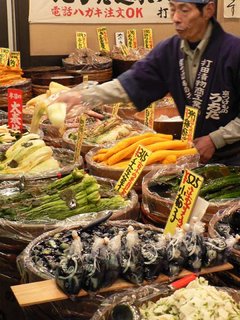 I dropped my pack at the hotel, but still had several hours before I would be allowed a bed to rest upon. So I wandered into the midst of downtown Kyoto and found myself on the main drag, surrounded by classy department stores. Impressive, but not what I had come to see. I struck off down a side street and came across a long undercover market selling every variety of Japanese food available. I was in heaven. Rice crackers, rice vinegar, rice wine, different grades of plain rice, rice pounded into mochi. Unidentifiable pickled vegetables, candies in minute design, barbequed skewered things, bread crumbed deep fried things. Some things packaged in layers upon layers, others opened for the prodding. There’s an essence of foreign food markets that tantalises the senses and emphasizes the differences between cultures more than
I dropped my pack at the hotel, but still had several hours before I would be allowed a bed to rest upon. So I wandered into the midst of downtown Kyoto and found myself on the main drag, surrounded by classy department stores. Impressive, but not what I had come to see. I struck off down a side street and came across a long undercover market selling every variety of Japanese food available. I was in heaven. Rice crackers, rice vinegar, rice wine, different grades of plain rice, rice pounded into mochi. Unidentifiable pickled vegetables, candies in minute design, barbequed skewered things, bread crumbed deep fried things. Some things packaged in layers upon layers, others opened for the prodding. There’s an essence of foreign food markets that tantalises the senses and emphasizes the differences between cultures more than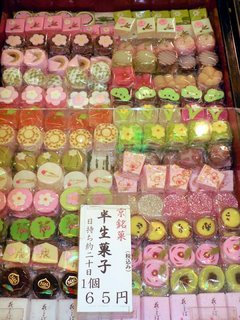 anything else. At such times I have mixed feelings about my vegetarianism. So many intriguing delicacies, so many that strike my stomach with fear and loathing! The camera came out and went click, click, click. A synthesized digital click to make the 35mm fan feel more comfortable. But the click is the same length whether the shutter speed is one sixtieth or one five hundredth. Somewhat disconcerting.
anything else. At such times I have mixed feelings about my vegetarianism. So many intriguing delicacies, so many that strike my stomach with fear and loathing! The camera came out and went click, click, click. A synthesized digital click to make the 35mm fan feel more comfortable. But the click is the same length whether the shutter speed is one sixtieth or one five hundredth. Somewhat disconcerting.I wound through back alleyways, through funky clothing districts, Gion, the theatre district, where I went chasing after Kabuki dancers in the touristy mission of another photograph.
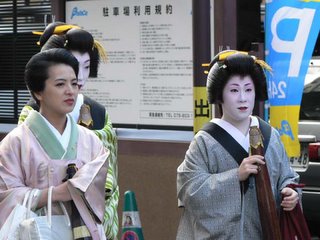 At first I thought they were Geisha, felt myself transported back into a more romantic era, the quintessence of the foreign conception of Japan. Geisha in Gion tripping down narrow alleyways in the impending evening to entertain wealthy, if not noble, men in teahouses scattered in quiet corners. But the surroundings were nothing like I’d imagined in the library of Japanese novels I’d been reading over the past fours years. But I was finally here and it was deliciously different and despite hoards of tourists, cars, modern buildings et al I was here - mind, body and spirit entwined.
At first I thought they were Geisha, felt myself transported back into a more romantic era, the quintessence of the foreign conception of Japan. Geisha in Gion tripping down narrow alleyways in the impending evening to entertain wealthy, if not noble, men in teahouses scattered in quiet corners. But the surroundings were nothing like I’d imagined in the library of Japanese novels I’d been reading over the past fours years. But I was finally here and it was deliciously different and despite hoards of tourists, cars, modern buildings et al I was here - mind, body and spirit entwined.I finally ended up outside Yasaka Shrine and Maruyama Park. Whilst looking for a toilet I found a noteworthy sign:
What to do in case of an earthquake.
Don’t rush outside.
Quickly put out fire.
Help neighbours.

The name Kobe came to mind, a city not so far away, forever connected to the idea of earthquakes in Japan, as Hiroshima and Nagasaki will always call forth more menacing connections. Over the next couple of days I would see these earthquake signs in localities all over Kyoto. I wondered why we didn’t have them on my little backwoods island of Shikoku. Were Japanese earthquakes too short ranged to reach the couple hundred kilometres away? Or does my country bumpkin island not rate as significant. The Marugame Earthquake. It doesn’t have quite the same ring. I hope. Thank goodness there’s only the Inland Sea between us and Kobe and not the Indian Ocean.
The steps leading up to the shrine were packed, as was the immediate complex. However a short walk towards the park and I found myself in a deserted temple complex and carried into my own personal nook of serenity. I breathed deep and long and moved on. I found a carp pond in the adjoining park and rested my weary legs on a sunny rock, hours of travel finally taking their toll.
Back at the hotel I was astonished and delighted to find the Book of Buddha in my bedside drawer, printed in both English and Japanese. I donned my yukatta and wriggled beneath a comfortingly heavy quilt.
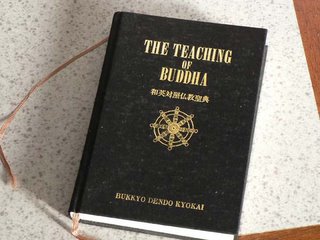
The next morning I awoke refreshed and happy! In Kyoto! A day of sightseeing ahead of me. I love these days where you wake up and know, for the whole day, you have only yourself to answer to. Yesterday I had my aimless wander; the joy of coming across unexpected adventures, today it was time for a more structured approach. A guidebook and several maps were in order, as was coffee and breakfast. In a cafe next to Kyoto Station, drinking bad coffee and munching on pancakes that had barely sniffed the advertised maple syrup, I decided two allocated destinations were necessary: a temple and a garden. Trying for anything more on a cold blustery day was foolishly begging for sore feet and over kill. Kyoto should be like dessert, where the exquisite aftertaste of a morsel is far preferable to feeling weary and bloated.
Kinkaku (Golden Pavilion) is the most famous temple in Kyoto. The day before I had seen hoards of tourists piling on buses bound there. Kinkaku was out. Leafing through assorted literature I found a temple that had a hall filled with 1001 female warriors, Sanjusangen Do. Destination number 1. Having seen enough sculpted trees to last a lifetime, a rock garden was my second priority, and thus destination number 2 would be Ryoanji Temple. As the temples were at either end of the city, I would also get to spend my day hopping on and off buses, hopefully getting lost in the meantime, a favourite pastime in strange cities.
Sanjusangen do was a long wooden hall. The name is derived from
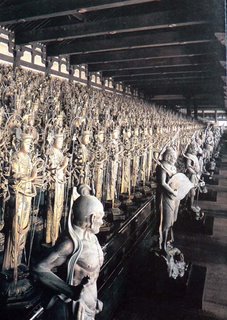 the architectural style and the thirty three spaces between the columns that support the building. There are 1001 statues of Kannon, the Buddhist goddess of mercy, each carved from cypress and coated with lacquer. In front of this army of goddesses are twenty eight other Hindu and Buddhist deities and in the middle is a huge Buddha. The original temple was burned down in 1249, but a faithful copy was reconstructed a short time after and has been standing ever since. No photos were allowed, which increased the atmosphere of reverence the temple had. A lone monk sat chanting in front of the central Buddha, and the air was filled with the smell of cedar wood and the continually burning candles and incense. Despite the unending procession of visitors the temple held a heavy aura of calm. As I regretfully left the building I felt as if time had slowed to half speed.
the architectural style and the thirty three spaces between the columns that support the building. There are 1001 statues of Kannon, the Buddhist goddess of mercy, each carved from cypress and coated with lacquer. In front of this army of goddesses are twenty eight other Hindu and Buddhist deities and in the middle is a huge Buddha. The original temple was burned down in 1249, but a faithful copy was reconstructed a short time after and has been standing ever since. No photos were allowed, which increased the atmosphere of reverence the temple had. A lone monk sat chanting in front of the central Buddha, and the air was filled with the smell of cedar wood and the continually burning candles and incense. Despite the unending procession of visitors the temple held a heavy aura of calm. As I regretfully left the building I felt as if time had slowed to half speed.I left Sanjusangen do and crossed the city on a
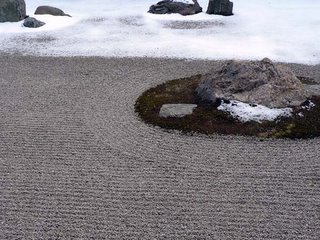 maze of buses. Luckily the bus drivers were pretty helpful and they also had guides at the main tourist interchange points. Walking up the drive towards Roanji do, the bushes sheltered patches of snow from the sunlight struggling valiantly down from above. The rock garden at Roanji do is probably the most famous Zen rock garden of its type. It comprises 15 rocks surrounded by a sea of gravel. I was looking forward to serenely contemplating this panorama for a long time and finding some zen of my own. Unfortunately they were currently renovating the garden wall, which left this
maze of buses. Luckily the bus drivers were pretty helpful and they also had guides at the main tourist interchange points. Walking up the drive towards Roanji do, the bushes sheltered patches of snow from the sunlight struggling valiantly down from above. The rock garden at Roanji do is probably the most famous Zen rock garden of its type. It comprises 15 rocks surrounded by a sea of gravel. I was looking forward to serenely contemplating this panorama for a long time and finding some zen of my own. Unfortunately they were currently renovating the garden wall, which left this  classic scene with a backdrop of tarps and scaffolding which somewhat killed the effect. The bustling, chattering crowd wedged onto a viewing platform at one side of the garden made any form of meditation impossible. I took a couple of interesting shots of the effect the line partially melted snow made across the gravel and headed off to explore the rest of the gardens. I found the beautiful Kyoyochi Pond, partially frozen over with mountainous rocks artfully protruding above the surface. Overhead, a late persimmon tree was showing off the last of its fruit.
classic scene with a backdrop of tarps and scaffolding which somewhat killed the effect. The bustling, chattering crowd wedged onto a viewing platform at one side of the garden made any form of meditation impossible. I took a couple of interesting shots of the effect the line partially melted snow made across the gravel and headed off to explore the rest of the gardens. I found the beautiful Kyoyochi Pond, partially frozen over with mountainous rocks artfully protruding above the surface. Overhead, a late persimmon tree was showing off the last of its fruit.It was still only early afternoon when I wandered out o
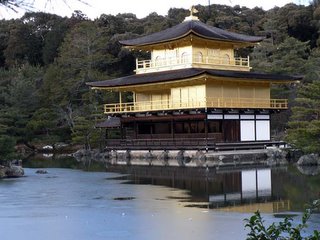 f Roanji do, and as I was in the immediate area I hopped on a bus up the road to Rokuon-ji do which houses the famed Kinkaku, or Golden Temple, so named because its walls are literally coated with a thick coat of gold. It has recently been restored and given a golden coat thicker than the original. On this crisp blue winter’s day the temple gleamed strikingly from its perch on the edge of the lake. The crowds jostling for position in the best vantage points couldn’t take away from the magnificence of this edifice and I was heartily glad I had come. I bought a postcard for my mum in the giftshop and found another score for myself; an English language cookbook on Japanese temple cooking, all of which, in true buddhist tradition, happens to be vegetarian. Tired and happy I scrambled onto a bus and spent the trip back to my hotel gazing over mouth watering dishes. My favourite so far is the tofu fried with almond.
f Roanji do, and as I was in the immediate area I hopped on a bus up the road to Rokuon-ji do which houses the famed Kinkaku, or Golden Temple, so named because its walls are literally coated with a thick coat of gold. It has recently been restored and given a golden coat thicker than the original. On this crisp blue winter’s day the temple gleamed strikingly from its perch on the edge of the lake. The crowds jostling for position in the best vantage points couldn’t take away from the magnificence of this edifice and I was heartily glad I had come. I bought a postcard for my mum in the giftshop and found another score for myself; an English language cookbook on Japanese temple cooking, all of which, in true buddhist tradition, happens to be vegetarian. Tired and happy I scrambled onto a bus and spent the trip back to my hotel gazing over mouth watering dishes. My favourite so far is the tofu fried with almond.
Subscribe to:
Comments (Atom)
